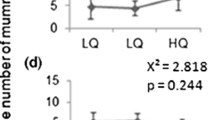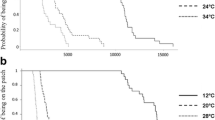Abstract
Models of prey choice in depleting patches predict an expanding specialist strategy: Animals should start as specialists on the most profitable prey and then at some point during patch exploitation switch to a generalist foraging strategy. When patch residence time is long, the switch to a generalist diet is predicted to occur earlier than when patch residence time is short. We tested these predictions under laboratory conditions using female parasitoids (Aphidius colemani) exploiting patches of mixed instars aphid hosts (Myzus persicae, L1 and L4). The duration of patch exploitation was manipulated by changing travel time between patches. As predicted, patch residence times increase with travel time between patches. Our results provide empirical support for the expanding specialist prediction: Parasitoid females specialized initially on the more profitable hosts (L4), and as the patch depleted, they switched to a generalist diet by accepting more frequently the less profitable hosts (L1). The point at which they switched from specialist to generalist occurred later when travel times and hence patch residence times were short. By affecting the patch exploitation strategy, travel time also determines the composition of hosts left behind, the “giving up composition.” The change in the relative density of remaining host types alters aphid populations’ age structure.


Similar content being viewed by others
References
Barrette M, Wu G-M, Brodeur J, Giraldeau LA, Boivin G (2009) Testing competing measures of profitability for mobile resources. Oecologia 158:757–764
Boivin G, Fauvergue X, Wajnberg E (2004) Optimal patch residence time in egg parasitoids: innate versus learned estimate of patch quality. Oecologia 138:640–647
Bonser R, Wright PJ, Bament S, Chukwu UO (1998) Optimal patch use by foraging workers of Lasius fuliginosus. L. niger and Myrmica ruginodis. Ecol Entomol 23:15–21
Brown JS (1988) Patch use as an indicator of habitat preference, predation risk, and competition. Behav Ecol Sociobiol 22:37–47
Brown JH, Mitchell WA (1989) Diet selection on depletable resources. Oikos 54:33–43
Brown JS, Morgan RA (1995) Effects of foraging behavior and spatial scale on diet selectivity: a test with fox squirrels. Oikos 74:122–136
Brown JH, Kotler BP (2004) Hazardous duty pay and the foraging cost of predation. Ecol Lett 7:999–1014
Charnov EL (1976a) Optimal foraging: attack strategy of a mantid. Am Nat 110:141–151
Charnov EL (1976b) Optimal foraging, the marginal value theorem. Theor Popul Biol 9:129–136
Davidson DW (1978) Experimental tests of the optimal diet in two social insects. Behav Ecol Sociobiol 4:35–41
Davies N (1977) Prey selection and the search strategy of the spotted flycatcher (Muscicapa striata): a field study of optimal foraging. Anim Behav 25:1016–1033
Dixon AFG (1977) Aphid ecology: life cycles, polymorphism, and population regulation. Annu Rev Ecol Syst 8:329–353
Dixon AFG (1985) Structure of aphid populations. Annu Rev Entomol 30:155–174
Emlen JM (1966) The role of time and energy in food preferences. Am Nat 100:611–617
Fletcher JP, Hughes JP, Harvey IF (1994) Life expectancy and egg load affect oviposition decision of a solitary parasitoid. Proc R Soc Lond B Biol Sci 258:163–167
Garb J, Kotler BP, Brown JS (2000) Foraging and community consequences of seed size for coexisting Negev desert granivores. Oikos 88:291–300
Giraldeau L-A, Kramer DL, Deslandes I, Lair H (1994) The effect of competitors and distance on central place foraging in eastern chipmunks, Tamias striatus. Anim Behav 47:621–632
Hayslette SE, Mirarchi RE (2002) Foraging-patch use and within-patch diet selectivity in mourning doves, Zenaida macroura. Ecology 83:2637–2641
Heller R (1980) On optimal diet in a patchy environment. Theor Popul Biol 17:201–214
Hofsvang T, Hågvar EB (1975) Duration of development and longevity in Aphidius ervi and Aphidius platensis (Hym.: Aphidiidae), two parasites of Myzus persicae (Hom.: Aphididae). Entomophaga 20:11–22
Holt RD, Kotler BP (1987) Short-term apparent competition. Am Nat 130:412–430
Houston AI (2009) Flying in the face of nature. Behav Processes 80:295–305
Hughes RN (1979) Optimal diets under the energy maximization premise: the effects of recognition time and learning. Am Nat 113:209–221
Jones G (1990) Prey selection by the greater horseshoe bat (Rhinolophus ferrumequinum): optimal foraging by echolocation? J Anim Ecol 59:587–602
Krebs JR, Erichsen JT, Webber MI, Charnov EL (1977) Optimal prey selection in the great tit (Parus major). Anim Behav 25:30–38
Krebs JR, Kacelnik A, Taylor P (1978) Test of optimal sampling by foraging great tits. Nature 275:27–31
Lucas JR, Schmid-Hempel P (1988) Diet choice in patches: time-constraint and state-space solutions. J Theor Biol 131:307–332
MacArthur R, Pianka E (1966) On optimal use of a patchy environment. Am Nat 100:603–609
McNamara JM, Houston AI (1987) Partial preferences and foraging. Anim Behav 35:1084–1099
McNamara JM, Houston AI, Weisser WW (1993) Combining prey choice and patch use: what does rate-maximizing predict? J Theor Biol 164:219–238
Mitchell WA (1990) An optimal control theory of diet selection: the effects of resource depletion and exploitative competition. Oikos 58:16–24
Mittelbach GG (1981) Foraging efficiency and body size: a study of optimal diet and habitat use by bluegills. Ecology 62:1370–1386
Pulliam HR (1974) On the theory of optimal diets. Am Nat 108:59–74
Rechten C, Avery M, Stevens A (1983) Optimal prey selection: why do great tits show partial preferences? Anim Behav 31:576–584
Richards LJ (1983) Hunger and the optimal diet. Am Nat 122:326–334
Schaefer JA, Messier F (1995) Winter foraging by muskoxen: a hierarchical approach to patch residence time and cratering behaviour. Oecologia 104:39–44
Schoener TW (1971) Theory of feeding strategies. Annu Rev Ecol Syst 2:369–404
Sih A, Christensen B (2001) Optimal diet theory: when does it work, and when and why does it fail? Anim Behav 61:379–390
Starý P (1975) Aphidius colemani Viereck: its taxonomy, distribution and host range (Hymenoptera, Aphidiidae). Acta Entomol Bohemoslov 72:156–163
Stephens DW, Krebs JR (1986) Foraging theory. Princeton University Press, Princeton
Stephens DW, Brown JS, Ydenberg RC (2008) Foraging: behavior and ecology. University of Chicago Press, Chicago
Tentelier C, Desouhant E, Fauvergue X (2006) Habitat assessment by parasitoids: mechanisms for patch use behavior. Behav Ecol 17:515–521
Thiel A, Hoffmeister TS (2004) Knowing your habitat: linking patch-encounter rate and patch exploitation in parasitoids. Behav Ecol 15:419–425
Visser ME, van Alphen JJM, Nell HW (1990) Adaptive superparasitism and patch time allocation in solitary parasitoids: the influence of the number of parasitoids depleting a patch. Behaviour 114:21–36
Völkl W, Mackauer M, Pell J, Brodeur J (2007) Predators, parasitoids and pathogens. In: van Emden H, Harrington R (eds) Aphids as crop pests. CAB International, Oxford, pp 187–233
Wajnberg E, Bernhard P, Hamelin F, Boivin G (2006) Optimal patch time allocation for time-limited foragers. Behav Ecol Sociobiol 60:1–10
Werner EE, Hall DJ (1974) Optimal foraging and the size selection of prey by the bluegill sunfish (Lepomis macrochirus). Ecology 55:1042–1052
Acknowledgments
This study and MB were financially supported by grants from the National Sciences and Engineering Research Council of Canada (NSERC) to GB, JB, and LAG. MB received additional financial support from a Graduate Scholarship from the Fonds Québécois de la Recherche sur la Nature et les Technologies (FQRNT) and a Major Fellowship from McGill University. We thank Jenny Vosburg and Josiane Vaillancourt for technical assistance with insects’ rearing.
Author information
Authors and Affiliations
Corresponding author
Additional information
Communicated by J. Lindström
Rights and permissions
About this article
Cite this article
Barrette, M., Boivin, G., Brodeur, J. et al. Travel time affects optimal diets in depleting patches. Behav Ecol Sociobiol 64, 593–598 (2010). https://doi.org/10.1007/s00265-009-0876-5
Received:
Revised:
Accepted:
Published:
Issue Date:
DOI: https://doi.org/10.1007/s00265-009-0876-5




